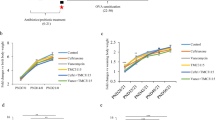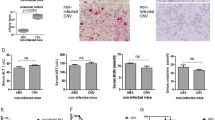Abstract
Clinical studies have confirmed that the use of antibiotics, especially carbapenems, is a high-risk factor for fungal infection in preterm infants. However, it is not entirely clear whether the increased risk for fungal infection is due to the immune differences in preterm infants or antibiotic usage. We found that after newborn rats received antibiotics, they exhibited significantly impaired anti–Candida albicans immunity in comparison with those without treatment, as shown by significantly increased levels of fungal glucan in the peripheral blood, multiple caseous fungal infections in the abdominal cavity, intestinal congestion, ischemia, and a decrease in the number of intestinal villi. Mechanistically, pretreatment with antibiotics diminished antifungal innate immunity by TLR2 and inhibited IL-17A release and neutrophil recruitment, leading to increased susceptibility to fungi. In summary, we demonstrate that antibiotic usage impairs antifungal immunity in neonates and suggest that antifungal prophylaxis may be required after antibiotic treatment in high-risk preterm babies.




Similar content being viewed by others
References
Pammi, M., et al., Candida parapsilosis is a significant neonatal pathogen: a systematic review and meta-analysis. 2013. 32(5): p. e206.
Agarwal, R.R., et al. 2017. Epidemiology of invasive fungal infections at two tertiary care neonatal intensive care units over a 12-year period (2000–2011). Global Pediatric Health 4: 2333794X1769668.
Romani, L. 2004. Immunity to fungal infections. Nature Reviews Immunology 4 (1): 11–24.
Huang, W., L. Na, P.L. Fidel, and P. Schwarzenberger. 2004. Requirement of interleukin-17A for systemic anti-Candida albicans host defense in mice. The Journal of Infectious Diseases 190 (3): 624–631.
Acosta-Rodriguez, E.V., L. Rivino, J. Geginat, D. Jarrossay, M. Gattorno, A. Lanzavecchia, F. Sallusto, and G. Napolitani. 2007. Surface phenotype and antigenic specificity of human interleukin 17–producing T helper memory cells. Nature Immunology 8 (6): 639–646.
Korn, T., E. Bettelli, M. Oukka, and V.K. Kuchroo. 2009. IL-17 and Th17 cells. Annual Review of Immunology 27: 485–517.
Curtis, M.M., and S.S. Way. 2009. Interleukin-17 in host defence against bacterial, mycobacterial and fungal pathogens. Immunology 126 (2): 177–185.
Savina, A., and S. Amigorena. 2007. Phagocytosis and antigen presentation in dendritic cells. Immunological Reviews 219 (1): 143–156.
Banchereau, J., and R.M. Steinman. 1998. Dendritic cells and the control of immunity. Nature 392 (6673): 245–252.
Rudner, X.L., K.I. Happel, E.A. Young, and J.E. Shellito. 2007. Interleukin-23 (IL-23)-IL-17 cytokine axis in murine Pneumocystis carinii infection. Infection and Immunity 75 (6): 3055–3061.
Zelante, T., A. de Luca, P. Bonifazi, C. Montagnoli, S. Bozza, S. Moretti, M.L. Belladonna, C. Vacca, C. Conte, P. Mosci, F. Bistoni, P. Puccetti, R.A. Kastelein, M. Kopf, and L. Romani. 2007. IL-23 and the Th17 pathway promote inflammation and impair antifungal immune resistance. European Journal of Immunology 37 (10): 2695–2706.
Bär, E., P.G. Whitney, K. Moor, C. Reis e Sousa, and S. LeibundGut-Landmann. 2014. IL-17 regulates systemic fungal immunity by controlling the functional competence of NK cells. Immunity 40 (1): 117–127.
Becattini, S., Y. Taur, and E.G. Pamer. 2016. Antibiotic-induced changes in the intestinal microbiota and disease. Trends in Molecular Medicine 22 (6): 458–478.
Kimura, Y., K. Chihara, C. Honjoh, K. Takeuchi, S. Yamauchi, H. Yoshiki, S. Fujieda, and K. Sada. 2014. Dectin-1-mediated signaling leads to characteristic gene expressions and cytokine secretion via spleen tyrosine kinase (Syk) in rat mast cells. Journal of Biological Chemistry 289 (45): 31565–31575.
Zhu, J., H. Yamane, and W.E. Paul. 2009. Differentiation of effector CD4 T cell populations. Annual Review of Immunology 28: 445–489.
Medzhitov, R. 2009. Approaching the asymptote: 20 years later. Immunity 30 (6): 766–775.
Gordon, S. 2002. Pattern recognition receptors: doubling up for the innate immune response. Cell 111 (7): 927–930.
Krajina, T., F. Leithäuser, P. Möller, Z. Trobonjaca, and J. Reimann. 2003. Colonic lamina propria dendritic cells in mice with CD4+ T cell-induced colitis. European Journal of Immunology 33 (4): 1073–1083.
Gil, M.L., and D. Gozalbo. 2006. TLR2, but not TLR4, triggers cytokine production by murine cells in response to Candida albicans yeasts and hyphae. Microbes and Infection 8 (8): 2299–2304.
Wang, Y., et al., Regional mucosa-associated microbiota determine physiological expression of TLR2 and TLR4 in murine colon. PLoS One, 2010. 5(10).
Hörmann, N., et al., Gut microbial colonization orchestrates TLR2 expression, signaling and epithelial proliferation in the small intestinal mucosa. PLoS One, 2014. 9(11).
Lundin, A., C.M. Bok, L. Aronsson, B. Björkholm, J.Å. Gustafsson, S. Pott, V. Arulampalam, M. Hibberd, J. Rafter, and S. Pettersson. 2008. Gut flora, toll-like receptors and nuclear receptors: a tripartite communication that tunes innate immunity in large intestine. Cellular Microbiology 10 (5): 1093–1103.
Zhou, W., H. Lv, M.X. Li, H. Su, L.G. Huang, J. Li, and W.M. Yuan. 2015. Protective effects of bifidobacteria on intestines in newborn rats with necrotizing enterocolitis and its regulation on TLR2 and TLR4. Genetics and Molecular Research 14 (3): 11505–11514.
Ivanov, I.I., R..L. Frutos, N. Manel, K. Yoshinaga, D.B. Rifkin, R.B. Sartor, B.B. Finlay, and D.R. Littman. 2008. Specific microbiota direct the differentiation of IL-17-producing T-helper cells in the mucosa of the small intestine. Cell Host & Microbe 4 (4): 337–349.
Atarashi, K., T. Tanoue, M. Ando, N. Kamada, Y. Nagano, S. Narushima, W. Suda, A. Imaoka, H. Setoyama, T. Nagamori, E. Ishikawa, T. Shima, T. Hara, S. Kado, T. Jinnohara, H. Ohno, T. Kondo, K. Toyooka, E. Watanabe, S.I. Yokoyama, S. Tokoro, H. Mori, Y. Noguchi, H. Morita, I.I. Ivanov, T. Sugiyama, G. Nuñez, J.G. Camp, M. Hattori, Y. Umesaki, and K. Honda. 2015. Th17 cell induction by adhesion of microbes to intestinal epithelial cells. Cell 163 (2): 367–380.
Davis, C., and D. Savage. 1974. Habitat, succession, attachment, and morphology of segmented, filamentous microbes indigenous to the murine gastrointestinal tract. Infection and Immunity 10 (4): 948–956.
Farkas, A.M., C. Panea, Y. Goto, G. Nakato, M. Galan-Diez, S. Narushima, K. Honda, and I.I. Ivanov. 2015. Induction of Th17 cells by segmented filamentous bacteria in the murine intestine. Journal of Immunological Methods 421: 104–111.
Gaboriau-Routhiau, V., S. Rakotobe, E. Lécuyer, I. Mulder, A. Lan, C. Bridonneau, V. Rochet, A. Pisi, M. de Paepe, G. Brandi, G. Eberl, J. Snel, D. Kelly, and N. Cerf-Bensussan. 2009. The key role of segmented filamentous bacteria in the coordinated maturation of gut helper T cell responses. Immunity 31 (4): 677–689.
Mazmanian, S.K., C.H. Liu, A.O. Tzianabos, and D.L. Kasper. 2005. An immunomodulatory molecule of symbiotic bacteria directs maturation of the host immune system. Cell 122 (1): 107–118.
Funding
This study was supported by grants from Guangzhou Hygiene and Health Commission Project (20191A011031).
Author information
Authors and Affiliations
Corresponding authors
Ethics declarations
The animal study was approved by the Institutional Animal Care and Use Committee of Guangzhou Medical University and carried out according to the institutional guidelines.
Additional information
Publisher’s Note
Springer Nature remains neutral with regard to jurisdictional claims in published maps and institutional affiliations.
Rights and permissions
About this article
Cite this article
Wang, P., Yao, J., Deng, L. et al. Pretreatment with Antibiotics Impairs Th17-Mediated Antifungal Immunity in Newborn Rats. Inflammation 43, 2202–2208 (2020). https://doi.org/10.1007/s10753-020-01287-w
Published:
Issue Date:
DOI: https://doi.org/10.1007/s10753-020-01287-w




